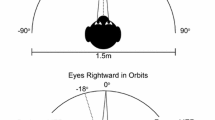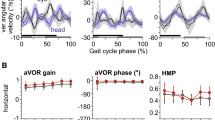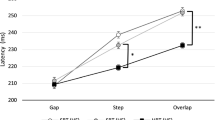Abstract
Changing the direction of the line of sight (gaze) can involve coordinated movements of the eyes and head. During gaze shifts directed along the horizontal meridian, the contribution of the eyes and head depends upon the position of the eyes in the orbits; the contribution of the head to accomplishing the overall shift in gaze declines as the eyes increasingly are deviated away from the direction of the ensuing gaze shift. Also during horizontal gaze shifts, changes in the metrics and kinematics of the saccadic (eye movement) portion of coordinated movements, are correlated with the amplitude and velocity of the concurrent head movement. With increasing head contributions, saccade peak velocities decline, durations increase and velocity profiles develop two peaks. It remains unknown whether the interaction between head and eyes observed during horizontal gaze shifts also occurs during vertical gaze shifts. Yet, a full understanding of the neural control of eye–head coordination will depend upon the correlation of neural activity and features of vertical as well as horizontal movements. This report describes the metrics and kinematics of vertical gaze shifts made by head-unrestrained rhesus monkeys. Key observations include: (1) during vertical gaze shifts of a particular amplitude, relative eye and head contributions depend upon the initial vertical positions of the eyes in the orbits; (2) as head contribution increases, peak eye velocities decline, durations increase and vertical velocity profiles develop two peaks; (3) head movement metrics and kinematics are accurately predictable given knowledge only of head movement amplitude. In these ways, vertical gaze shifts were found to be qualitatively similar to horizontal gaze shifts. It seems probable that similar mechanisms mediate head–eye interactions during both horizontal and vertical movements. These observations are consistent with the hypothesis that a signal proportional to vertical head velocity reduces the gain of the vertical saccade burst generator.











Similar content being viewed by others
References
Bahill AT, Clark MR, Stark L (1975) The main sequence, a tool for studying human eye movements. Math Biosci 24:191–204
Baloh RW, Konrad HR, Sills AW, Honrubia V (1975) The saccade velocity test. J Neurol 25:1071–1076
Becker W, Jürgens R (1990) Human oblique saccades: quantitative analysis of the relation between horizontal and vertical components. Vision Res 30:893–920
Collewijn H (1977) Eye- and head movements in freely moving rabbits. J Physiol 266:471–498
Collewijn H, Erkelens CJ, Steinman RM (1988a) Binocular co-ordination of human horizontal saccadic eye movements. J Physiology 404:157–182
Collewijn H, Erkelens CJ, Steinman RM (1988b) Binocular co-ordination of human vertical saccadic eye movements. J Physiol 404:183–197
Corneil BD, Olivier E, Richmond FJ, Loeb GE, Munoz DP (2001) Neck muscles in the rhesus monkey. II. Electromyographic patterns of activation underlying postures and movements. J Neurophysiol 86:1729–1749
Delreux V, Abeele SV, Lefevre P, Roucoux A (1991) Influences of eye position on the control of head movement amplitude. In: Paillard J (ed) Brain and space. Oxford University Press, Oxford, pp 38–48
Freedman EG (2001) Interactions between eye and head control signals can account for movement kinematics. Biol Cybern 84:453–462
Freedman EG, Quessy S (2004) Electrical stimulation of rhesus monkey nucleus reticularis gigantocellularis II. Effects on metrics and kinematics of ongoing gaze shifts to visual targets. Exp Brain Res 156:357–376
Freedman EG, Sparks DL (1997) Eye–head coordination during head-unrestrained gaze shifts in rhesus monkeys. J Neurophysiol 77:2328–2348
Freedman EG, Sparks DL (2000) Coordination of the eyes and head: movement kinematics. Exp Brain Res 131:22–32
Fuller JH (1992) Head movement propensity. Exp Brain res 92:152–165
Goossens HHLM, vanOpstal AJ (1997) Human eye–head coordination in two dimensions under different sensorimotor conditions. Exp Brain Res 114:542–560
Guitton D, Douglas RM, Volle M (1984) Eye–head coordination in cats. J Neurophysiol 52:1030–1050
Huebner WP, Paloski WH, Reschke MF, Bloomberg JJ (1995) Geometric adjustments to account for eye eccentricity in processing horizontal and vertical eye and head movement data. J Vesitibular Res 5:299–322
Judge SJ, Richmond BJ, Chu FC (1980) Implantation of magnetic search coils for measurement of eye position: an improved method. Vision Res 20:535–538
Phillips JO, Ling L, Fuchs AF, Seibold C, Plorde JJ (1995) Rapid horizontal gaze movement in the monkey. J Neurophysiol 73:1632–1652
Robinson DA (1964) The mechanics of human saccadic eye movement. J Physiol 174:245–264
Stahl J (1999) Amplitude of human head movements associated with horizontal saccades. Exp Brain Res 126:41–54
Stahl JS (2001) Eye–head coordination and the variation of eye-movement accuracy with orbital eccentricity. Exp Brain Res 136:200–210
Tomlinson RD (1990) Combined eye–head gaze shifts in primate III. Contributions to the accuracy of gaze saccades. J Neurophysiol 64:1873–1981
Tomlinson RD, Bahra PS (1986) Combined eye–head gaze shifts in the primate I. Metrics. J Neurophysiology 56:1542–1557
Tweed D, Glenn B, Vilis T (1995) Eye–head coordination during large gaze shifts. J Neurophysiol 73:766–799
Volle M, Guitton D (1993) Human gaze shifts in which the head and eyes are not initially aligned. Exp Brain Res 94:463–470
Yee RD, Schiller VL, Lim V, Baloh FG, Baloh RW, Honrubia V (1985) Velocities of vertical saccades with different eye movement recording methods. Invest Ophthalmol Vis Sci 26:938–944
Acknowledgements
The author thanks Dr. Gil Rivlis for development of data acquisition and behavioral control software, and G. Parker for technical assistance. This work is supported in part by NEI EY13239 and NSF IBN-0132335. Additional support provided by the Center for Visual Science (NEI P30-EY01319).
Author information
Authors and Affiliations
Corresponding author
Rights and permissions
About this article
Cite this article
Freedman, E.G. Head–eye interactions during vertical gaze shifts made by rhesus monkeys. Exp Brain Res 167, 557–570 (2005). https://doi.org/10.1007/s00221-005-0051-9
Received:
Accepted:
Published:
Issue Date:
DOI: https://doi.org/10.1007/s00221-005-0051-9




